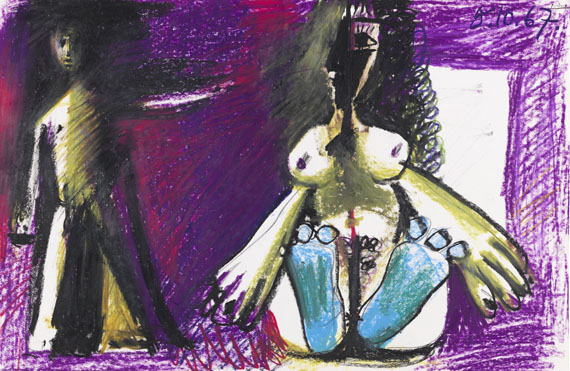Dictionary


Early Cubism
The first period of Cubism, from around 1906 to 1910, is often regarded as early Cubism. The period is dominated by two outstanding artist personalities, Pablo Picasso (1881-1973) and Georges Braque (1882-1963).
After his Blue (1901-04) and Rose Period (1905-06), that were dedicated to the artistic exploration of the figure and its symbolic content, Pablo Picasso was looking for new artistic options. He found inspiration in the work of Paul Cézanne, in Spain's archaic sculpture, in folk art of the South Sea and the distorted African masks with their reduced basic geometric forms. It is particularly the interest in art of native people that connects early Cubism with Primitivism.
Picasso's painting "Les Démoiselles d´Avignon", made in early summer in 1907, is regarded as the founding work of Cubism. Picasso dared to break with painting conventions and dissolved figure and space into sharp-edged forms. For most of his contemporaries, the picture was nothing less than a shock. However, Georges Braque, who had been experimenting with Fauvism, was enthusiastic about it and created his "Grande Nu" again in a similar style in 1908.
Both painters had a common interest in the newly discovered way of painting and were also on cordial terms with each other, a friendship that led to an intensive artistic cooperation as of 1908. During this period, both artists attained similar results, so that it is sometimes hard to tell their works apart. The difference is only in the amount of paintings, Picaso executed some 1000 cubist works, whereas a mere 120 paintings were made by the hand of Georges Braque.
Works from this early cubist period are characterized by a sharp-edged fragmentation of forms, stylization, a deficit of perspective and a tendency to simplify forms and colors (approach to monochrome art). Unlike later phases of the style, early Cubism is still tied in with plastic volume and local color values.
Georges Braque, who occupied more than just a congenial role in the early cubist cooperation with Picasso, introduced the landscape (inspired by Paul Cézanne) and the still life as well as the "papier collé".
The first period of Cubism, from around 1906 to 1910, is often regarded as early Cubism. The period is dominated by two outstanding artist personalities, Pablo Picasso (1881-1973) and Georges Braque (1882-1963).
After his Blue (1901-04) and Rose Period (1905-06), that were dedicated to the artistic exploration of the figure and its symbolic content, Pablo Picasso was looking for new artistic options. He found inspiration in the work of Paul Cézanne, in Spain's archaic sculpture, in folk art of the South Sea and the distorted African masks with their reduced basic geometric forms. It is particularly the interest in art of native people that connects early Cubism with Primitivism.
Picasso's painting "Les Démoiselles d´Avignon", made in early summer in 1907, is regarded as the founding work of Cubism. Picasso dared to break with painting conventions and dissolved figure and space into sharp-edged forms. For most of his contemporaries, the picture was nothing less than a shock. However, Georges Braque, who had been experimenting with Fauvism, was enthusiastic about it and created his "Grande Nu" again in a similar style in 1908.
Both painters had a common interest in the newly discovered way of painting and were also on cordial terms with each other, a friendship that led to an intensive artistic cooperation as of 1908. During this period, both artists attained similar results, so that it is sometimes hard to tell their works apart. The difference is only in the amount of paintings, Picaso executed some 1000 cubist works, whereas a mere 120 paintings were made by the hand of Georges Braque.
Works from this early cubist period are characterized by a sharp-edged fragmentation of forms, stylization, a deficit of perspective and a tendency to simplify forms and colors (approach to monochrome art). Unlike later phases of the style, early Cubism is still tied in with plastic volume and local color values.
Georges Braque, who occupied more than just a congenial role in the early cubist cooperation with Picasso, introduced the landscape (inspired by Paul Cézanne) and the still life as well as the "papier collé".
Offers




